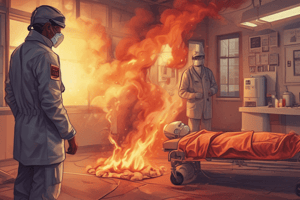Podcast
Questions and Answers
What is the primary purpose of administering TPA during a stroke?
What is the primary purpose of administering TPA during a stroke?
- To replace lost insulin
- To reduce blood pressure
- To hydrate the patient
- To dissolve blood clots (correct)
Hypoglycemia refers to high blood sugar levels that can be life threatening.
Hypoglycemia refers to high blood sugar levels that can be life threatening.
False (B)
What are the two types of Diabetes Mellitus?
What are the two types of Diabetes Mellitus?
Type I and Type II
Excessive loss of water can lead to a condition called ______.
Excessive loss of water can lead to a condition called ______.
Match the following conditions with their descriptions:
Match the following conditions with their descriptions:
What condition is described as a failure of the cardiovascular system to maintain adequate blood pressure?
What condition is described as a failure of the cardiovascular system to maintain adequate blood pressure?
Choking requires the use of CPR as the first response to the emergency.
Choking requires the use of CPR as the first response to the emergency.
What can chronic hyperglycemia lead to?
What can chronic hyperglycemia lead to?
What are the symptoms of orthostatic hypotension?
What are the symptoms of orthostatic hypotension?
Type I Diabetes Mellitus can be managed through diet and exercise alone.
Type I Diabetes Mellitus can be managed through diet and exercise alone.
What is the term used to describe diabetes in children due to obesity?
What is the term used to describe diabetes in children due to obesity?
In case of burns, it is important to prevent __________ contamination.
In case of burns, it is important to prevent __________ contamination.
Match the medical emergency with its appropriate management:
Match the medical emergency with its appropriate management:
A sudden lack of water intake or excessive loss can lead to ______.
A sudden lack of water intake or excessive loss can lead to ______.
What is a significant risk of internal bleeding?
What is a significant risk of internal bleeding?
Which of the following is NOT a type of shock?
Which of the following is NOT a type of shock?
In an emergency situation of autonomic dysreflexia, it is important to relax the SNS.
In an emergency situation of autonomic dysreflexia, it is important to relax the SNS.
What is the first step in managing a conscious patient experiencing a cardiac arrest?
What is the first step in managing a conscious patient experiencing a cardiac arrest?
During a seizure, it is crucial to protect the patient's __________ from injury.
During a seizure, it is crucial to protect the patient's __________ from injury.
What is a common cause of myocardial infarction?
What is a common cause of myocardial infarction?
Flashcards are hidden until you start studying
Study Notes
Basic Principles of Management in a Medical Emergency
- Early recognition and intervention are critical in managing medical emergencies.
- Understanding patient history and symptoms enhances treatment effectiveness.
Signs, Symptoms, and General Management of Selected Medical Emergencies
External Bleeding/Lacerations
- Prompt control of bleeding is essential to prevent shock.
Shock
- Defined as cardiovascular failure leading to inadequate blood pressure and oxygen delivery to tissues.
- Causes can include decreased circulating blood volume.
- Four types: Hypovolemic, Cardiogenic, Distributive, and Obstructive.
Orthostatic (Postural) Hypotension
- Occurs when blood pressure drops upon standing from a sitting or lying position.
- Symptoms include dizziness, lightheadedness, cold sweats, and possible syncope (fainting).
- Caused by blood pooling in lower extremities, reducing venous return, cardiac output, and cerebral blood flow.
Fractures
- Immediate immobilization is key to prevent further injury and manage pain.
Burns
- Objectives include preventing wound contamination, alleviating pain, and preventing shock.
Seizures
- Ensure patient safety by protecting from injury and maintaining modesty.
Choking
- Basic life support techniques like the Heimlich maneuver may be necessary.
Autonomic Dysreflexia
- An exaggerated sympathetic nervous system response to noxious stimuli, often in patients with spinal cord injuries.
Cardiac Arrest/Myocardial Infarction (MI)
- Caused by obstruction of coronary arteries leading to tissue death of the myocardium.
- In conscious patients: Position in a comfortable way, assess breathing, administer medications if applicable, and call 911.
- In unconscious patients: Follow CAB (Circulation, Airway, Breathing) procedure and call 911 prior to CPR.
Stroke (Cerebrovascular Accident - CVA)
- Early recognition is critical; ischemic strokes may benefit from TPA administration within 3 hours.
- Public education on early warning signs improves response rates and outcomes.
Internal Bleeding
- Often a result of trauma; can be life-threatening if not assessed and treated swiftly.
Diabetes Mellitus (DM)
- Characterized by chronic hyperglycemia affecting metabolism of carbohydrates, fats, and proteins.
- Two types:
- Type I (IDDM): Requires insulin injections due to lack of production.
- Type II (NIDDM): Managable through diet and exercise, sometimes requiring medications.
Hypoglycemia
- Low blood sugar levels can be life-threatening; requires prompt treatment.
Hyperglycemia
- High blood sugar levels may lead to diabetic coma; urgent management is important.
Dehydration
- Excessive water loss or inadequate intake can lead to hypovolemia and shock if untreated.
Studying That Suits You
Use AI to generate personalized quizzes and flashcards to suit your learning preferences.



